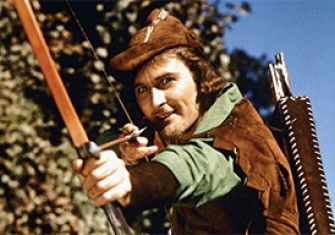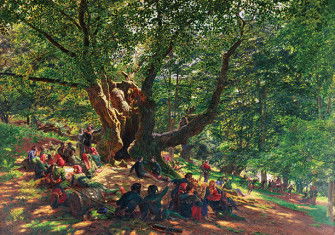Robin Hood the Brute
Criminal biographers of the 18th century portrayed Robin as a cold-blooded killer.

Between 1714 and 1737, Robin Hood’s reputation took a beating. In criminal biography, the most popular genre of literature, Robin was portrayed as a cold-hearted killer.
It is best to briefly digress, however, to explain why criminal biography emerged when it did.
In the 18th century crime was the subject on everybody’s lips, and people believed that they were in the midst of a crime wave. The situation apparently became so bad by mid-century that Henry Fielding gloomily prophesied:
I make no doubt, but that the streets of [London], and the roads leading to it, will shortly be impassable without the utmost hazard.
The legal response to this crime wave was the introduction of a bloody law code, when 200 offences became capital felonies. This resulted in the proliferation of cheap criminal biographies. Major novelists of the period also capitalised on this market for criminal biographies, and Daniel Defoe’s novel Moll Flanders (1722) is often seen as a more sophisticated example of the genre. The first appearance of Robin Hood in criminal biography comes in Captain Smith’s A History of the Lives and Robberies of the Most Noted Highwaymen (1719), where he is listed as ‘Robin Hood: A Highwayman and Murderer.’ Robin also makes an appearance in Captain Johnson’s Lives and Actions of the Most Noted Highwaymen (1734), as well as the anonymous The Whole Life and Merry Exploits of Bold Robin Hood (1737). The content of Smith’s Highwaymen was heavily plagiarised for subsequent accounts of Robin’s life, and it is Smith’s text which is focused upon here.
Today we are told that Robin Hood was the noble Earl of Huntingdon, but Smith was not convinced:
This bold robber, Robin Hood, was, some write, descended of the noble family of the earls of Huntingdon; but that is only fiction, for his birth was but very obscure, his pedigree ab origine being no higher than poor shepherds, who for some time lived in Nottinghamshire, in which county, at a little village adjacent to the Forest of Sherwood, he was born in the reign of King Henry the Second.
Robin Hood’s social status, however, is fairly immaterial to the reader of criminal biography in the 18th century. As the scholar Lincoln B. Faller points out, there was no concept of a ‘criminal class’ in 18th-century England, and offenders were not sociologically different from law-abiding people (as it was supposed in the 1800s). Instead all men were capable of committing a crime because all men were sinners. You became a criminal if, like Robin, you allowed yourself to succumb to your own sinful inclinations.
Smith tells how Robin Hood was ‘bred up a butcher, but being of a very licentious, wicked inclination, he followed not his trade, but in the reign of King Henry the Second, associated himself with several robbers and outlaws’. We are told that Robin Hood steals from the rich and gives to the poor, but in the 18th century people often rolled their eyes when they heard of thieves doing this. When one highwayman in 1763, Paul Lewis, told an official that he stole from the rich and gave to the poor, the sarcastic response was that this was ‘a common excuse for all thieves and robbers’. Even Robin’s meeting with the king is played out differently to how it is portrayed in movies today, for in Smith’s work, instead of the meeting ending amicably, Robin simply robs him:
The King, seeing it was in vain to resist Robin Hood’s power, he [sic] gave him a purse in which was about 100 pieces of gold; but swore when he was got out of his clutches that he would certainly hang him whenever he was taken.’
Evidently, the 18th-century Robin Hood is loyal to no man, not even the king.
Finally, Smith portrays Robin Hood as a man who is wicked until the day he dies, for he records that:
Robin Hood had continued in his licentious course of life for 20 years, when being very sick, and then struck with some remorse of conscience, he privately withdrew himself to a monastery in Yorkshire, where being let blood by a nun, he bled to death, aged 43 years, and was buried in Kinslay.
The reason that Robin’s reputation is thoroughly revised here is because he was a murderer, guilty of the most heinous crime which was viewed as a direct attack on God. It was believed that God himself directly intervened in the detection and punishment of murder, just as The Theatre of God’s Judgement (1748) declared that:
The justice of God riseth up, and with his own arme he discovereth and punisheth the murder; yea, rather than the murderer shall go unpunished, senceless creatures and his own heart and tongue rise to give sentence against him.
In Smith’s account, Robin’s own heart had risen up against him, having been ‘struck with some remorse of conscience’, and it was then, when he sought refuge in a monastery, that he was finally punished for his wicked ways.
These appearances of Robin Hood in criminal biography are part of a range of literature in which fears and anxieties relating to the rise of crime during the 18th century were expressed. In a crime-ridden society, it made no sense to readers to identify and sympathise with a robber and murderer. Of course, some 18th-century highwaymen such as Jack Sheppard (1702-54) became popular fellows, but this was the exception rather than the norm, and the romanticisation of highwaymen only occurred later in the 1830s with the rise of the Newgate novel.
Criminal biographies, moreover, were intended to serve as pieces of moralist literature. Readers were supposed to heed the warnings of the life of the criminal to avoid making the same sinful mistakes that had led felons to the gallows. Eighteenth-century authors had a more nuanced and, dare it be said, ‘realistic’ impression of the type of man that Robin may have been like, if he existed at all. And finally, it was actually only during the late 18th and early 19th centuries that Robin Hood’s ‘hero’ status was firmly established in the works of Joseph Ritson (1752-1803) and Sir Walter Scott (1771-1832), and to them do we owe our modern interpretation of Robin Hood.
Stephen Basdeo is a Ph.D. Candidate at Leeds Trinity University. @sbasdeo1






